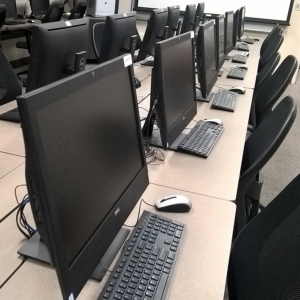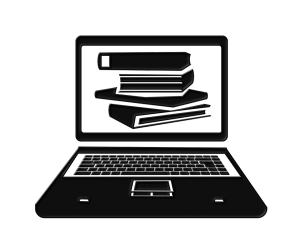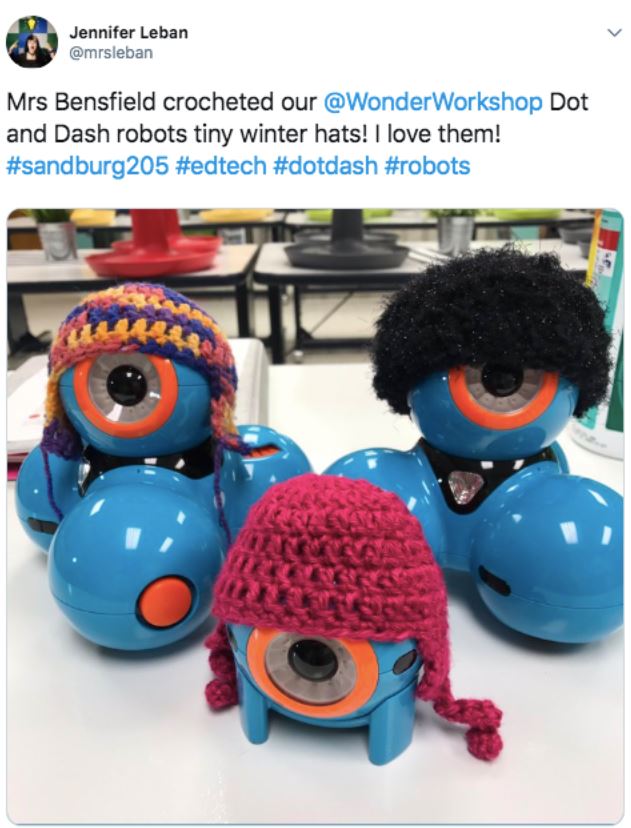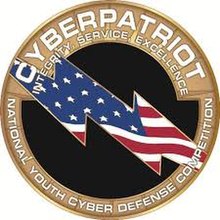Search the Blog
Categories
- Books & Reading
- Broadband Buzz
- Census
- Education & Training
- Friday Reads
- General
- Grants
- Information Resources
- Library Management
- Nebraska Center for the Book
- Nebraska Libraries on the Web
- Nebraska Memories
- Now hiring @ your library
- Preservation
- Pretty Sweet Tech
- Programming
- Public Library Boards of Trustees
- Public Relations
- Talking Book & Braille Service (TBBS)
- Technology
- Uncategorized
- What's Up Doc / Govdocs
- Youth Services
Archives
Subscribe
Tag Archives: Pretty Sweet Tech
Pretty Sweet Tech: Holiday & Winter Tech Kit Activities
Most of you probably know we offer Tech Kits Through the Mail to school and public libraries in Nebraska. But did you know that many of those kits have really fun holiday and winter themed activities? Check out a kit and try one one or all of these activity ideas this winter:
- Dash & Dot Winter Activities (age 6+): Design your own winter parade floats and program them around a parade obstacle, record your own winter theme song, challenge your friends to a snowball fight, and more!
- Finch 2.0 Robot Winter (age 6+): Turn your robot into a snowplow, build a holiday parade and add a green screen backdrop if you’re feeling fancy, or create a fun winter window display.
- Hummingbird Bit Premium (age 8+): Take your winter window display up a notch, craft and program an interactive winter story scene, or add a moving background to your winter parade video!
- Ozobot Evo Robot (age 4+): Design a Winter Wonderland and challenge others to navigate your creation, create a fun snow maze, use the plow attachment to clean the streets, or use your imagination to visit Narnia!
- Micro:bit (age 8+): Make an LED snow globe animation using the built-in display, blow out an LED candle or program your micro:bit to let you know when the sun is finally out again.
Find a full list of kits, or check out a Tech Kit Through the Mail using this link. Here are the loan program details:
- Kits can be checked out for 30 days at a time.
- You can check out multiple kits at once.
- Kits are shipped to you for free, and use of the kits is free.
- You only pay return shipping. (Some library systems may help offset these costs. Ask your system director if this is an option near you.)
- Check out the Tech Kit Loan Policy for more details.
I hope you have some winter wonderland fun with the Tech Kits Through the Mail!
Posted in Pretty Sweet Tech, Programming, Technology, Youth Services
Tagged Pretty Sweet Tech, stem, Tech Kits, Tech Kits Through the Mail
Leave a comment
Pretty Sweet Tech: CyberPatriot’s National Youth Cyber Defense Competition
Cybersecurity is one of the top growing tech careers in the nation. The Air Force Association started their CyberPatriot’s National Youth Cyber Defense Competition to help middle and high school students explore cybersecurity careers by taking on the role of a cybersecurity systems administrator, working to prevent and address cyber threats to a small business. CyberPatriots is now the world’s largest cybersecurity competition!
Eligibility: The competition is open to all schools and approved youth organizations, including Boys & Girl Scout troops, STEM groups, libraries, and homeschool groups. School and public libraries are encouraged to apply!
Learn more about the competition structure, team member requirements, costs, and tech requirements on the CyberPatriot website.
Registration is due by October 3, 2023 so start planning now!
While you’re on the site, check out the Air Force’s other cybersecurity resources for senior citizens:
- CyberGenerations: This pre-packaged program is designed to introduce senior citizens to cybersecurity basics, password management, common internet threats, scams and fraud, and social media safety. CyberGenerations offers a Self-Paced Guide, and Workshop Resources to help facilitate virtual or in-person workshops.
- Tech Caregiver: This training course with resources and guides certifies trainers to assist senior citizens to safely operate online. This is a good course to get comfortable facilitating CyberGenerations workshops in your community.
Posted in Education & Training, General, Pretty Sweet Tech, Programming, Technology
Tagged Pretty Sweet Tech, prettysweettech, Programming, stem, technology
1 Comment
Pretty Sweet Tech: Are We Used to Learning Online?
With more schools and libraries closing during the Coronavirus pandemic, we are made to focus on online learning and digital resources for both patrons and librarians. This doesn’t have to be a bad thing.
I put together a Digital Literacy Guide with plenty of resources to learn technology, digital skills, and life skills for any and every subject. The skills in the “How and Where to Learn Online” are helpful for both librarians and patrons who would like to expand technology, business, and a variety of other skills.
Elsewhere on this page are tips and tricks to study and stay organized when learning online from home. It seems easy, but time management can be difficult with distractions from family members and entertainment options. Learning online from home also requires a different level of concentration. Going on the computer at home is sometimes associated with leisure time, or other activities. How do we change the mindset to get stuff done and work towards a goal? The “Best Practices for Learning Online” section can help with these issues.
Finding health information, news sources, and evaluating information is also part of learning online. Find tips and tricks for this here as well.
I hope you all stay safe and well during this pandemic. If you do get quarantined, try to see it as an opportunity to build new skills online. You can come back stronger, smarter and prepared to take on the world!
Posted in General, Pretty Sweet Tech, Technology
Tagged online learning, Pretty Sweet Tech, technology
Leave a comment
Pretty Sweet Tech: Lesson Plans for Community Planning

As the population grows in Lincoln, we are faced with growing transportation, housing, environmental, economic, and a variety of other problems. Similar categories are found in areas across the state and around the world. These problems are not always seen as the most pressing or fancy problems on the planet, but they are important.
Many of the problems facing us now and in the future require us to look at the problem from many different angles so we can solve the problem for everyone, not just a vocal few. So I’m planning a set of lesson plans that are interdisciplinary, and is not locked down to just one piece of technology. This lesson plan mimics the way we would encounter technology in the real world. Life doesn’t happen in subjects. The community is our classroom.
Over the next several blog postings, I will be building the foundation for this series of lesson plans.
Introduction
Our goal is to find ways to build a better community. Consider this scenario: Your city is planning a new housing development and wants to ensure this new area has room for upward mobility, access to resources, and is sustainable in every way. The city wants to encourage ride-sharing, provide quality affordable housing, job options, and sustainable living. As city planners, you can help make that happen.
First we need to learn more about the people who will live in these houses. What do they want out of life? How do they prefer to live? What is and isn’t working with what we are doing now?
Lesson 1 Overview: Dreaming
In this lesson we will consider what makes a good community living arrangement. What are the life goals of the community members? Is the current environment helping, or hurting? How do we live now, and how would we prefer to live? Not just the housing itself, but the full community. What makes a good place to live?
Lesson 2 Overview: Planning & Demographics
It’s time to do a bit of research and planning for this new community. We know what we want in a community. What about others? Which income bracket needs housing? Is there room for upward mobility? What are the current and/ or desired demographics that make up your community? Where are the local businesses? Where do people work? All the questions.
Lesson 3 Overview: Outside Influences
What are the systems at play here? Here we will use the Sustainable Development Goals as a rough guide to determine which systems are at play. It helps to have a full picture of what our community members are dealing with when designing and building the best community possible.
Lesson 3 Overview: Potential Solutions
It’s time to decide which of the factors we discovered are most important. We can’t make everyone happy, but we can do the best we can with what we have available. Start designing solution concepts. Which other systems do we need to work with to accomplish our goals? Build teams.
Lesson 4 Overview: Try It & Adjust
How do we knew our plan is working? What do we need to learn along the way to build a better community? Which tools, technologies and systems would make our lives easier?
It is at this point that we can introduce technology tools and instruction. The next sections of this lesson plan will focus on a variety of technologies and how to assess applicability, sustainability, and identify tools that help.
Without laying the foundation above, we are simply learning new tools. How do we know these tools are making a positive contribution to our communities if we don’t know what kind of community we are striving towards? Let’s see how this idea shapes up over time.
If you’re interested in testing this series of lesson plans in your community, please contact me at amanda.sweet@nebraska.gov. Let’s try something new.
Posted in General, Pretty Sweet Tech, Technology
Tagged Pretty Sweet Tech, technology, Technology Innovation Librarian
Leave a comment
Pretty Sweet Tech: Voice Assistant Lesson Plan
This is a quick and easy lesson plan I put together to demonstrate how searching for information online is vastly different from using a voice command to retrieve information via Amazon Echo, Google Home Mini, or another voice assistant. How do we determine which information is best when we can’t see it to verify?
Lesson Duration: 45-60 minutes
Audience: Adults, Teens, 6-8th grade
Prerequisites:
- Basic website navigation skills
- Keyboard/ Mouse skills
- Able to use voice-enabled device (ex. Google’s Get Started with Voice Access). Other instructions found on device-specific website.
Learning Objectives:
- Understand how voice controlled technology impacts the understanding and selection of information.
- Brainstorm new ways to analyze information using voice commands.
- Understand why we need to verify sources.
Materials:
- Computers with internet access
- Smart device with voice assistant enabled (ex. Amazon Echo, Google Home, smartphone)
- Notebook & Pen, or Electronic note-taking device
Lesson Preparation:
- Set up all computers and devices. Make sure the internet is connected on all devices.
- Charge devices before class, or have outlet access.
- Make sure devices have microphone and voice assistant enabled, if using a device other than Amazon Echo or Google Home.
Lesson Outline:
Voice command devices like Amazon Echo are getting more popular by the day. Do we know how this new convenience will affect information seekers? Let’s find out. This activity is designed to compare the different between looking up information online versus finding and retrieving information verbally. We will explore the pros and cons to accessing information using voice commands.
Introduction (5-10 minutes):
- Introduce instructor
- Explain the popularity of voice-command enabled devices.
- Show examples of devices and how they are used in the world.
- Warm-Up Activity: Ask if anyone has used voice commands in their everyday life to find information, control devices, or otherwise interact with the world. Have voice commands ever given you an unexpected result?
Finding Information Online Activity (10 Minutes):
Whether it’s a recipe, the latest news headlines, a DIY video, or information about a health concern, we all find information online every now and again. I would like you to find a current events headline. When you find it, jot down how you know the information is real.
Discussion:
- How did you decide this information was real?
- What is your source?
- Can you find another article reporting similar information?
Guidelines for Real vs. Fake (5 Minutes):
Take a look at this Real or Fake infographic from the International Society for Technology in Education (ISTE) to see how the experts spot fake news. Did your news story prove to be real or fake? How can you tell? Have a brief discussion.
Voice-Command Information (15-20 Minutes):
Take out your voice-command device. Use the wake word and ask the device to find information about a current events topic. Find an article and look back at that Real or Fake inforgraphic.
Discussion:
- Using only voice commands, how can you tell if this is real?
- Can you find all the verification information listed on the infographic?
- Was it easy or difficult to find information to verify the source?
- Would you use voice commands as your only way to find information?
- What do you think will happen as more people find information using voice-command enabled device without a screen?
Conclusion (5 Minutes):
- Sum up what the learners discovered during the activities.
- Ask the learners if they have any questions or would like to learn more about any of the topics covered.
- Remind everyone to search safely and find good information!
Posted in General, Pretty Sweet Tech, Technology
Tagged Pretty Sweet Tech, prettysweettech, technology, voice commands
Leave a comment
Pretty Sweet Tech: Augmented Books
Books aren’t going anywhere anytime soon. But they might be augmented! In fact, they already are. Check out this video from Quiver AR:
Quiver Augmented Reality is an app that can be downloaded for Android or iOS. Coloring pages can be downloaded and printed from Quiver’s website. There are a combination of free and paid options for coloring pages.
If you can color inside the lines, you can use this app. It’s a kid favorite, but fun for adults as well. Here are some quick setup tips and tricks:
- Go to http://www.quivervision.com/apps/ to download Quiver. Start with regular Quiver, then test out the others later.
- Download and print coloring pages: http://www.quivervision.com/coloring-packs/#
- Color!
- In the Quiver app, press “Packs” in the middle of the screen. Choose and download the image pack for the coloring page you chose.
- After downloading, press the “Butterfly icon” in the upper right corner to access the app.
- Press the “Butterfly” icon at the bottom to access the camera
- Aim your camera at the coloring page. (You may need to tap the screen to focus).
- Watch your freshly colored image come to life!
- Repeat steps 2-7 with other coloring page packs.
As simple as that, books can come to life! Now imagine how this can affect book publishing in the future. Picture books just got a whole lot more interactive. Textbooks can have better graphics for improved learning.
We can also pair books with the real world. Imagine the world as your coloring book. Start with a textbook, then pull the digital image into the real world. Learning is about to get a lot more interesting.
It’s time to change the way we think about books. Who said I have to choose between eBooks and print books? I want both. Let’s start asking different questions in the library. Change the game.
P.S. Email me at amanda.sweet@nebraska.gov if you want to find out how to build your own augmented and virtual reality worlds.
Posted in General, Pretty Sweet Tech, Technology
Tagged Pretty Sweet Tech, technology
Leave a comment
Pretty Sweet Tech: Easy Makerspace Projects
Every library should have a handful of quick and easy makerspace projects on hand. Here’s a quick list with resources for your reference:
Paper Circuits: A piece of paper, some copper conductive tape, a small battery, printable templates, and an LED light bulb is all you need to set up this project. Go to Makerspaces.com for paper circuit kits and instructions.
SparkFun also has kits and downloadable templates available.
Marble Run: Don’t lose your marbles! Just grab some craft sticks and a cardboard box to set up this fun marble maze. Frugal Fun for Boys and Girls has instructions and pictures.
Pom Pom Drop: Collect toilet paper and paper towel rolls, then grab some colorful tape and a cheap pom pom ball to make this cool project from Coffee Cups and Crayons.
Newspaper Projects: If you have some newspaper to recycle, try upcycling in these projects from Edventures with Kids!
Cardboard Loom: Try your hand at weaving with this cardboard loom from Instructables.
Microwave Ivory Soap: When in doubt, microwave your Ivory soap and watch it grow.
Check out these projects, then peruse the other projects available on these sites to find some quick and easy projects for the kids in your library!
Posted in General, Pretty Sweet Tech, Technology
Tagged Pretty Sweet Tech, stem, technology
Leave a comment
Pretty Sweet Tech: Artificial Intelligence in the Library
Artificial Intelligence (AI) is powerful when it fades quietly into the background. AI-4-All, a non-profit organization with education programs for high school students, describes AI as “a branch of computer science that allows computers to make predictions and decisions to solve problems”. It’s simple, but it’s true. Ideally, AI would be used to solve problems like hunger, environment safety, safe drinking water, disease diagnosis, and crime stopping. In many cases, this is exactly how AI algorithms are used.

However, that is not how the average person is impacted by AI on a daily basis. Each day, our computers make predictions about our search terms, recommended spelling, phrasing in texts, and which products we might want to buy. Mostly the last one. The question is how these predictions are made. What factors go into the decision-making process?
Most importantly, what does this have to do with the library? Honestly, everything. Here’s a list:
- Search Engine Rankings: When library patrons Google your library, an AI algorithm is used to determine which listings appear on the list. If you want the library to appear in searches for local events, you will need to know what Google’s algorithm is looking for in your listing.
- Search Assistance: Librarians help people find information. A great deal of information is found behind search engines powered by AI. Know the tips and tricks to use Google, and find what Google can’t.
- Privacy & Security: AI is fed by mass quantities of data. That data is generated by us. Every click, search entry, map location, post and video viewed can be tracked and fed into a user profile. Libraries can help people sort out where data goes and know their rights and responsibilities to keep themselves safe in a digital world.
- Internet of Things: With devices being powered by the internet and generating more data, it is more important now than ever to lay a good foundation for data awareness and security.
- Deep Fakes & Fake News: Unfortunately, both AI and humans are generating more fake news, fake comments, and all around bad things. Help people identify fake articles, videos, and comments.
Luckily, libraries are in a good place to tackle the information world. Let’s help our communities stay safe and well-informed.
Posted in General, Pretty Sweet Tech, Technology
Tagged Pretty Sweet Tech, technology
Leave a comment
Pretty Sweet Tech: Tech Communities Need

Did you ever wonder what the tech is happening in the world? The thought crosses my mind often, but that may be a hazard of the trade. Technology is piling up faster, but what actually matters to us and our communities? How can technology be used as a tool to help people?
Why Would People Want to Learn?
The best place to start is to look at your community demographics. Are there more high school students, or older adults? Are adults trying to build skills for a changing future? Which technology do people already use? Is technology being used effectively?
When you have a better idea of who your library is serving, dig deeper into why technology is necessary. Here are some possibilities:
- Do people want to build professional development skills?
- Which professions are most common in the area?
- Do parents want to learn how to help their kids?
- Do people want to use digital tools for work?
- Is your community using tech tools to improve public services?
We have reached a point where technology has extended to the full power of the internet. We use our devices to communicate, shop online, manage finances, learn new skills, create new content, share ideas, and more. Not everyone needs access to every corner of the World Wide Web. But the people who know what’s possible will thrive in a digital world.
So What is Possible?
Too much is possible. Trying to gather everything under the sun is an exercise in futility. The internet can do a paralyzing number of things.
Start by narrowing focus on one demographic and technology need at a time. Consider these examples:
Demographic 1: Parents helping kids use smartphones responsibly
Possibilities: Look at screen time balance, device safety and security, online predators, and learning how to learn online.
How Libraries Can Help: Gather digital literacy resources, including articles, infographics, and posters. Set up parent discussion groups with informational handouts. Possibly work with the local school to help parents keep up with changing technology.
Demographic 2: Adults who have been in the workforce, but want to learn new technology to keep current.
Possibilities: As technology grows more complex, people who did not have access growing up, or were not previously interested may wish to be exposed to new technology. Jobs may require new exposure as well.
How Libraries Can Help: Connect adults with resources to learn about emerging technology trends. Deloitte and Gartner’s Trends are good places to start. When people know what exists, they can decide for themselves if it is relevant to their current needs. Potentially, try a makerspace for interested patrons.
So What Does this Mean?

If you were looking for a one-size-fits all solution, I can’t give you one. It doesn’t exist. Technology is going to keep on changing, and we will all have to adapt as it happens. Apps and devices will change, but the underlying concepts will remain the same.
What are these concepts? Privacy and security concerns, communication skills, creative application of ideas, flexible learning and unlearning, online finance skills, cooperative learning, and staying healthy and well in a digital world. Those skills will extend outward to every bit of technology.
Posted in General, Pretty Sweet Tech, Technology
Tagged Pretty Sweet Tech, technology
Leave a comment
Pretty Sweet Tech: How Do People Find Your Library?
 Last weekend, I was looking for something new to do in the area. I grabbed my phone and searched for “events in Lincoln”. The downtown Haymarket website popped up, so did EventBrite, Meetup.com, the local newspaper, and the city of Lincoln website. That made me wonder, how do people find library events? Technology has changed the landscape here.
Last weekend, I was looking for something new to do in the area. I grabbed my phone and searched for “events in Lincoln”. The downtown Haymarket website popped up, so did EventBrite, Meetup.com, the local newspaper, and the city of Lincoln website. That made me wonder, how do people find library events? Technology has changed the landscape here.
I’ve also gotten several questions recently about advertising events on the Nebraska Libraries on the Web sites. Often times we only put our events on the library website, or on flyers posted around the library. But that limits the number of people in the community who will consistently see event marketing. Only frequent library-goers will likely know about the event. Our library events have always competed for people’s time and attention. With the ease of finding events online, that competition has increased considerably.
What Can Libraries Do?
Start p osting your events in multiple locations. Where do you and your staff go to find local events? Ask around to find out which websites people of different age groups are currently using. If attendance is low, it may be time to start advertising like the “competitors”.
osting your events in multiple locations. Where do you and your staff go to find local events? Ask around to find out which websites people of different age groups are currently using. If attendance is low, it may be time to start advertising like the “competitors”.
Does this Cost Money?
Many of these sites allow local businesses and organizations to post for free. Meetup.com sounds like a dating website, but it is actually a great place to advertise local events, book club meetings, and community gatherings. Meetup.com has a $15 a month fee for organizers so it may not be worth it for a few events. However, if you can share costs between other city organizations, and Meetup.com is already known to be popular in your town, it may be worth the cost sharing!
Google Your City Events
Open the common search engines (Google, Bing, DuckDuckGo, etc.) and search for events in your city. What did you find? Reach outside the library walls to let your community know what’s up and coming in your library. You can use the same advertising graphics and wording across multiple websites to save time. This can especially come in handy if you go through Nebraska Libraries on the Web. Check that out if you’re a Nebraska library and want to start a new website or revamp your existing site.
Pretty Sweet Tech: Mobile Device Safety Resources
 Mobile and general online security has been a concern for many. This post points out two great resources for online and mobile security.
Mobile and general online security has been a concern for many. This post points out two great resources for online and mobile security.
1. The Federal Trade Commission put together this Smartphone Security Checker to help people ensure their own mobile safety. This tool will allow you to select your mobile operating system, then pull up a list of ten detailed safety tips and tricks. The available operating systems are Android, Apple iOS, BlackBerry, and Windows Phone.
How libraries can use this tool:
- Incorporate the tool into one-on-one device training sessions.
- Provide a printed handout at the reference desk
- Train staff to practice using the tool with different operating systems to better assist patrons in the future
- Update library devices to use some of these security measures
- Update your personal device safety measures
2. The Federal Trade Commission also put together a great tool to Recover from Identity Theft. Unfortunately, identity theft is now relatively commonplace. In some cases the theft extends to only credit card information and can be remedied by calling the bank, cancelling the card, and trying to reverse any charges that may have gone through.
In other cases, the identity thief may have gotten hold of social security numbers. If the thief was able to use the information, the victim may have a bigger problem.
This tool works sort of like a reference interview. The system asks a series of questions to find out what happened and learn more about the context of the situation, then connects the user with appropriate resources. The tool is designed to build a customized plan to recover from various degrees of identity theft or compromised information.
How libraries can use this tool:
 People have a tendency to seek information only when they have an immediate information need. This is one tool we hope nobody ever needs. However, it can be helpful to have a brochure available at the reference desk to let people know the tool exists. Victims of identity theft can be in a vulnerable place and may not always know the right questions to ask in the moment.
People have a tendency to seek information only when they have an immediate information need. This is one tool we hope nobody ever needs. However, it can be helpful to have a brochure available at the reference desk to let people know the tool exists. Victims of identity theft can be in a vulnerable place and may not always know the right questions to ask in the moment.
This is also a good tool to bring up during device training, computer and internet use assistance, and other technology training. It’s better to be safe than sorry when it comes to identity theft.
Hopefully these tools come in handy in your library. In the case of identify theft, hopefully nobody ever has a need!
Posted in General, Pretty Sweet Tech, Technology
Tagged digital literacy, Pretty Sweet Tech, technology
Leave a comment
Pretty Sweet Tech: Data Breaches and Data Brokers, Oh My!
 Today, we talk about data brokers. They’re part of the reason Best Buy ads keep chasing me around the web. These are the organizations running behind the scenes of marketing, government data pools, identity verification services, background checks, and so much more.
Today, we talk about data brokers. They’re part of the reason Best Buy ads keep chasing me around the web. These are the organizations running behind the scenes of marketing, government data pools, identity verification services, background checks, and so much more.
There are over 4,000 data broker companies worldwide, but we’re going to look at Acxiom, one of the world’s largest data brokers. This is the power of information today. Currently, Axciom has global data in over 60 countries, has information about over 2.5 billion people, and their website boasts over 10,000 attributes about each individual person.
Honestly, this would probably make marketers salivate. Those little information nuggets are solid gold for data miners everywhere. But it’s not the information that matters, it’s how you use it that counts. Data brokers scrape information from public records, purchase data from companies, then clean, analyze, repackage, and license clean data to companies.
First we’ll look at the type of information these brokers collect in their 10,000+ attributes, then we’ll explore how it is analyzed and used in real life.
Type of Information Collected (from Axciom’s website):
- Individual Demographics (ex. age, gender, ethnicity, education, occupation)
- Household Characteristics (ex. occupants, number/age of children)
- Financial (ex. income ranges, net worth, economic stability)
- Life Events (ex. marriage, divorce, new children, moving)
- Interests (ex. sports, leisure, pets, entertainment)
- Buying Activities (ex. purchase history, method of payment)
- Behavior (ex. community involvement, causes)
- Major Purchases (ex. home buying, cars, property, technology)
How do they know life events and interests? Social media is one way. Looking at Facebook’s website, they have a marketing insights page for businesses. Facebook deep dives into your social media activity, tracks keywords in posts, and knows all your major life events. Then they sell it to data brokers, or directly to companies. Data brokers then take this information, and resell it to more companies. Facebook isn’t the only one.
How is the Information Used?
 There are four major categories of how your information is being used:
There are four major categories of how your information is being used:
- Marketing and Advertising (ex. online ads, emails)
- Fraud Detection (ex. verification of identify for a loan by a bank)
- Risk-Mitigation (ex. can track overspending, or health stats to determine eligibility for health insurance or financial loans)
- People-Search Sites (used for background searches for landlords, employers, curious friends/ family, or anyone who wants to pay to see your history)
What About Data Breaches?
Sometimes this information gets into the wrong hands. Hackers get into large pools of information all the time in data breaches. No company is ever completely safe from a data breach. That is like saying the Titanic is unsinkable.
Did you ever think about where your information goes when you go online? We still had a digital footprint before the internet exploded. Companies still tracked your purchases and interests, but now they can do it more efficiently. Consider what you want people to know about you online.
Posted in General, Pretty Sweet Tech, Technology
Tagged Pretty Sweet Tech, technology
Leave a comment
Pretty Sweet Tech: Where Can Patrons Learn Tech Skills?
 There’s a question that keeps coming up in makerspaces: how can we help patrons learn the higher level skills they want to learn? A lot of times, people come in to practice using the entry level tools, but want to learn more. Technology is moving quickly. This is a time for life-long learning.
There’s a question that keeps coming up in makerspaces: how can we help patrons learn the higher level skills they want to learn? A lot of times, people come in to practice using the entry level tools, but want to learn more. Technology is moving quickly. This is a time for life-long learning.
Imagine This Scenario:
Someone walks into the library who already has their bachelors degree and has no desire for more student loans. They want information about where to go to learn new technology skills. How would you answer? This could be a pretty common question soon.
How I Would Answer:
Part of what I do is what I call the “technology reference interview”. This is a way to narrow down just exactly what the patron wants to accomplish. Do they want to be able to complete one project as a hobby, or pick up a new skill to use at work? How will they prove they learned the new skill, and will they require written proof from an organization? This takes practice, just like learning how to ask the right questions to recommend books.
The Resources:
For a hobby, try tutorials on YouTube, or audit a free micro-credential. These are short courses offered by universities and other organizations to help support life-long learning. Some of these are advertised as free courses to audit, others are paid right off the bat. Those needing certification can pay for a micro-credentials or certification that is often cheaper than a standard degree, and can be done over time. Here are some options:
- Udacity: This is great for learning coding skills from different categories, from beginner to advanced. This site is mostly paid courses or varying lengths. A small selection of the courses they partnered with Google to create are offered for free. Overall, courses can be taken individually or in an over-arching micro-degree program.
- Udemy: This is more of a crowd-sourced course platform. It will also help people learn coding skills from beginner to advanced. Some courses are made by professionals, others are made by people who are just getting started. Check out the reviews on individual courses, and watch the preview of the course. Make sure the learning style used in the courses meshes with how you learn.
- EdX: Many of these courses were put together by Harvard, MIT, or other top universities. They cover a range of topics from how to leverage technology in business, to robots in society, to artificial intelligence in everything. Some learners like the learning style from EdX, others like Udacity or Udemy more.
- Coursera: This site is pretty similar to EdX. The courses are mostly made by universities and many offer free auditing. With an audited course you won’t get the graded assignments, but you do have access to learning resources.
- FutureLearn: This is a mix of universities from around the world, and varying organizations for an alternative learning approach. The Raspberry Pi Foundation offers several courses tied to their product on this site.
Long story short, there are plenty of options. Encourage people to shop around, audit courses and find a site and instructor style that works for them personally. The resources exist to learn the skills, it just takes time and patience to learn. I would include the disclaimer that not all organizations, workplaces, industries, or higher education institutions accept micro-credentials. It’s a shifting and growing field, but for building new skills, they can be awesome.
Posted in General, Pretty Sweet Tech, Technology
Tagged Pretty Sweet Tech, technology
Leave a comment
Pretty Sweet Tech: Why Do We Need Computers?
Quite often people make the point that we all got along fine without computers several decades ago, so why do we need them now? Honestly, it’s a good question.
So let’s take a moment to look at how and why we use computers now. As of 2018, 90% of adults in the U.S. use the Internet for some purpose in their lives. Here’s how most people use the internet:
- 90.8% access email

- 90.2% use test or instant message
- 74.4% use social media
- 69.5 watch videos or media online
- 68.5 go shopping or make reservations
- 65.9% use bank online or pay bills
- 52.6% stream music
- 46.6% use online video calls/ communication
- 22.6% work remotely
- 20.8% search for jobs
- 19.1% take classes online
Looking at the list of the activities U.S. adults most frequently do online, do we need computers? To answer that, we can ask ourselves a few questions:
1. Does technology make any daily tasks easier? Examples are banking, communicating with others, shopping, or accessing entertainment options.
2. What would we lose access to if we didn’t have the internet?
3. Are computers primarily helping people, or hurting?
4. Is there anything you would change about how you use the internet?
5. How do people communicate online? Is it effective?
6. Are computers harming any aspect of life?
7. Are there any major threats to personal safety?
8. How do we interact with people before the internet vs. after?
9. Are there any new opportunities provided by the internet?
10. How much time do you spend on the internet?
Consider the way you use computers. If they are predominantly helpful, keep doing what you’re doing. If you went through this list and saw a few things you would like to change, why not make a few adjustments?
Technology is designed to help people. Think about how you feel about computers. If computers aren’t helping you, change the way you use computers. If a specific program or website is stressing you out, you don’t have to go there. Take control of technology.
Pretty Sweet Tech: Makerspace Highlights
I’ve been running around creating makerspace goodness this week, so this is going to be a short post. It’s all about makerspaces and some of the cool things you can get for your makerspace. This is great whether you’re just starting out, or want to spice up your existing offerings:
Merge Cube: This looks like a little foam cube, but it is oh, so much more. Paired with a smartphone, you can overlay amazing 3D images onto this magical little cube. Take a look at the video on Merge Cube’s home page to see it in action. There are ways to use pre-made projects, or to create your own using an app!
 Dash and Dot Robots: These robots are great for kids of all ages. Dash is geared towards kids 6 and up, while Dot is geared for kids 11 and up. But adults can use them too! I’m a big kid now. These robots have plenty of great pre-made curriculum and project ideas too!
Dash and Dot Robots: These robots are great for kids of all ages. Dash is geared towards kids 6 and up, while Dot is geared for kids 11 and up. But adults can use them too! I’m a big kid now. These robots have plenty of great pre-made curriculum and project ideas too!
LEGO Mindstorms: This is a robot that will let you build the actual bot, then program it as well! I train this one for the Innovation Studios grant, so I can answer a bunch of questions about this one. It’s geared towards 8 and up, but it has a lot of flexibility to be hacked by adults too. Good times.
Paper Circuits: If you’re looking for low-cost ways to show the basics of circuitry and electronics, this book is a great place to start. Makerspaces.com also has quite a few other project ideas.
 Arduino for Beginners: Makerspaces.com also has this great book showing you everything you need to know about Arduino for beginners. You’ll learn how the board works, some simple circuits, and to interact with the right software.
Arduino for Beginners: Makerspaces.com also has this great book showing you everything you need to know about Arduino for beginners. You’ll learn how the board works, some simple circuits, and to interact with the right software.
There are plenty of other makerspace options out there. But this is a start. I chose mostly all low-cost options. The bigger machines like 3D printers, laser cutters, vinyl cutters, and all that fun stuff are also out there. Feel free to email me at amanda.sweet@nebraska.gov if you have any questions, or would like some recommendations.
Posted in General, Pretty Sweet Tech, Technology
Tagged makerspaces, Pretty Sweet Tech
Leave a comment
Pretty Sweet Tech: DigitalLearn for Digital Skills!
If you have library patrons who are just starting to use computers, or want to learn more about how to use them well, DigitalLearn, made by the Public Library Association (PLA) is a good way to go. They cover everything from why we need computers, to online privacy basics, and tips for buying plane tickets online.
Who Should Use This Resource?
 If you’re wondering who this resource is geared towards, the blurb on top of DigitalLearn’s site says it all: “If you are new to computers, haven’t used them for a while, are a little unsure and uncomfortable, or just need a bit of a refresher, we have the tools to help you tackle technology at your own pace and gain the confidence you need to succeed.”
If you’re wondering who this resource is geared towards, the blurb on top of DigitalLearn’s site says it all: “If you are new to computers, haven’t used them for a while, are a little unsure and uncomfortable, or just need a bit of a refresher, we have the tools to help you tackle technology at your own pace and gain the confidence you need to succeed.”
The site is written in clear, easily understood language. Each tab has a set of short videos, each video has a PDF version, just in case users learn better by reading instead of watching videos. Everybody learns differently. Some of the videos also have additional worksheet exercises users can fill out if they want more guidance on the path towards computing.
How Can Librarians Use This to Help Patrons in Person?
DigitalLearn has several pre-made courses, complete with handouts and materials, for you to teach classes in person at your library. Each section has an Instructor’s Guide, Activity Sheet, and a Handout. Some of the classes have PowerPoint presentations, practice files and a few other things. All in all, these materials will make it a whole lot easier for you to start offering more digital literacy in your library. Without having to take time to create materials from scratch. It’s a win-win!
Nebraska Library Commission’s Upcoming Digital Literacy Class
We’re gearing up for more digital literacy here at the Library Commission as well. The course is still being researched and put together, but if you have any recommendations, feel free to comment on this post, or email amanda.sweet@nebraska.gov.
Posted in Education & Training, Pretty Sweet Tech, Technology
Tagged digital literacy, Pretty Sweet Tech, technology
Leave a comment
Pretty Sweet Tech: Who Regulates the Internet?
 If somebody walked up to your library’s reference desk and asked “who regulates the internet? What if I see something bad?” What would you say?
If somebody walked up to your library’s reference desk and asked “who regulates the internet? What if I see something bad?” What would you say?
Honestly, this is a tough question because the answer varies so much. By and large, there isn’t much regulation from any one governing body in the United States. Let’s dig a little deeper into this idea by breaking it down into smaller categories:
Online Advertising
Ads online are regulated on several levels:
Federal: The Federal Trade Commission has a set of resources available to learn about guidelines, rules, and recommendations for buyers and sellers online.
State: According to Truth in Advertising.org, Nebraska has a Consumer Protection Division through the Office of the Attorney General that files complaints against false advertisements. The also includes a link to Nebraska’s advertising laws.
Self-Regulated: Many website and organizations are also setting their own policies for advertisements on their pages. A thorough example is Google’s Ads Policies.
Online Content
Removing harmful content like fake news, hate speech, instructions for how to perform criminal acts, and other poor online behavior is largely self-regulated from site to site. The internet is a big place and it’s hard for a large regulatory authority to grapple with that much content. Right now it’s most’y up to websites and all of us to self-regulate and report harmful content directly to sites like YouTube, Facebook, or Google.
Access to Internet
 Federal: The Federal Trade Commission has a set of policies in place for access to the internet and how people can be charged for services. These policies only pertain to communications online, like email, VoIP services, and some connectivity issues.
Federal: The Federal Trade Commission has a set of policies in place for access to the internet and how people can be charged for services. These policies only pertain to communications online, like email, VoIP services, and some connectivity issues.
The debate over Net Neutrality has been raging for quite some time. Rather than hash out the whole debate in this post, check out the current state of affairs by looking at the National Conference of State Legislatures’ Net Neutrality 2019 Legislation. There’s a chart on this page that will let you know what Nebraska is doing in comparison to other states. You can also check out this video: BBC What is Net Neutrality?
Summary
The internet is basically a whole other world. Under which regulatory authority would you place internet services? The internet does communication, data collection, advertising, online commerce, and pretty much everything under the sun. Who regulates what?
For now, libraries can start connecting people with existing resources, and start to get people thinking about what they would like to see out of the internet. What helps, and what hurts in the world wide web?
Posted in General, Pretty Sweet Tech, Technology
Tagged internet, Pretty Sweet Tech, technology
Leave a comment
Pretty Sweet Tech: Libraries Ready to Code
 Coding is no secret. In fact, there’s an almost paralyzing amount of information available to people. So much that it can be difficult to decide where to start and where to go next. Knowledge of computers and technology is rapidly becoming vital to life, but many people don’t have a computer science or technology background. And that’s okay.
Coding is no secret. In fact, there’s an almost paralyzing amount of information available to people. So much that it can be difficult to decide where to start and where to go next. Knowledge of computers and technology is rapidly becoming vital to life, but many people don’t have a computer science or technology background. And that’s okay.
In 2017, the American Library Association (ALA) and Google saw this and partnered together to make Libraries Ready to Code. Librarians and educators from 30 different libraries worked on their own project to decide what “coding” means to them and how to best introduce it to their own communities. The result is s set of tools that has been made freely available to us all.
This resource is geared towards all experience levels, so you can filter resources by experience level: “I’m Getting Started”, “I’ve Had Some Practice”, and “I’m Experienced”. Some of these resources are further divided into subject categories like art and fashion, while others are parceled out by recommended age range. Either way, this resource is a great place to connect K-12 students with computational thinking and “coding” skills.
 But keep in mind that this is just a drop in the bucket of what is available. Not everyone learns the same way either. Feel free to look to these learning tools as inspiration to build your own. Think of Libraries Ready to Code as a starting point on the long road towards future-ready technology.
But keep in mind that this is just a drop in the bucket of what is available. Not everyone learns the same way either. Feel free to look to these learning tools as inspiration to build your own. Think of Libraries Ready to Code as a starting point on the long road towards future-ready technology.
Keep an eye out for students who devour every resource on this list, then ask for more. Ask them what they want to learn, then do a little digging to find out which resources you need to make it happen. You might not know every line of code that makes a product work, but you can connect interested students with the information they need to learn.
At one time, information took the form of books and journal articles. Now that information may appear in a Raspberry Pi or YouTube video. It’s time to curate our ever-changing resources. But do yourself a favor and don’t try to learn every bit of technology on the planet. You would be in for a world of hurt.
Start asking students to teach as they learn. There is no telling what people are capable of when given the tools to learn. Take a look at this Virtual Reality headset and software built by a group of high school students in France. Their passion was to make technology accessible to all income levels. They learned more thoroughly with the intent to teach. Virtual Reality, Augmented Reality, machine learning and more are all at our fingertips.
Technology is not slowing down, and neither are libraries. We can work together to curate resources and pave the way towards a better future.
Posted in General, Pretty Sweet Tech, Technology, Uncategorized
Tagged coding, Pretty Sweet Tech, technology
Leave a comment



